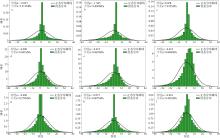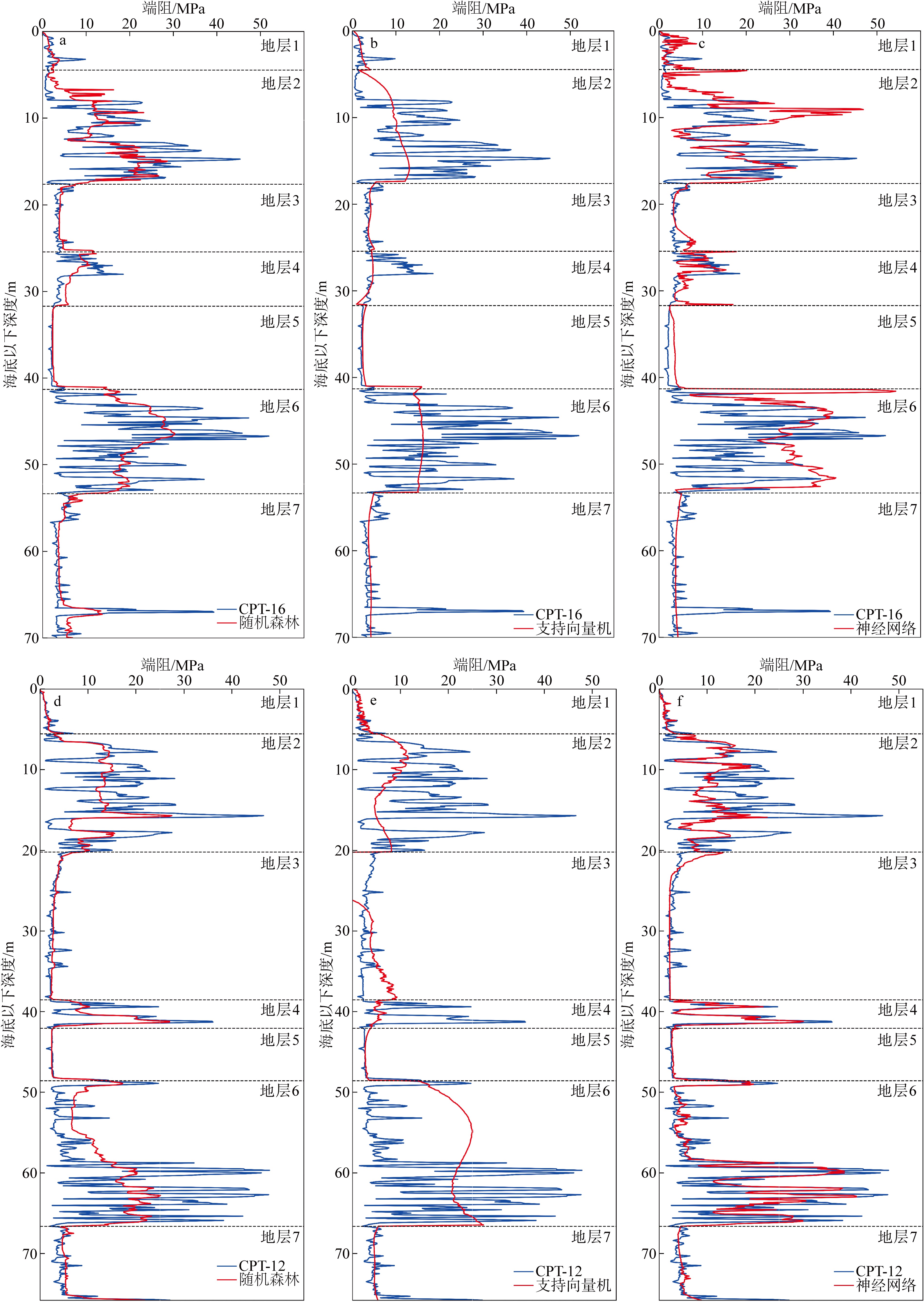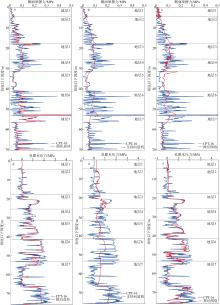Journal of Tropical Oceanography ›› 2025, Vol. 44 ›› Issue (4): 14-24.doi: 10.11978/2024228
• Marine Geology • Previous Articles Next Articles
A machine learning-based method for predicting shallow subsurface CPT parameters in offshore wind farms
LI Shuzhao1( ), WEI Che1, SHEN Chen1, SUN Guodong1, YANG Yetao2(
), WEI Che1, SHEN Chen1, SUN Guodong1, YANG Yetao2( ), LUO Jinhua3, WANG Jiaolong3
), LUO Jinhua3, WANG Jiaolong3
- 1. CNOOC Research Institute Ltd., Beijing 100028, China
2. Institute of Geophysics & Geomatics, China University of Geosciences (Wuhan), Wuhan 430074, China
3. China Oilfield Services Limited, Tianjin 300459, China
-
Received:2024-12-04Revised:2025-01-02Online:2025-07-10Published:2025-07-31 -
Contact:YANG Yetao -
Supported by:China "14th Five-Year Plan" Major Science and Technology Project(KJZX-2022-12-XNY-0100)
CLC Number:
- P714+.6
Cite this article
LI Shuzhao, WEI Che, SHEN Chen, SUN Guodong, YANG Yetao, LUO Jinhua, WANG Jiaolong. A machine learning-based method for predicting shallow subsurface CPT parameters in offshore wind farms[J].Journal of Tropical Oceanography, 2025, 44(4): 14-24.
share this article
Add to citation manager EndNote|Reference Manager|ProCite|BibTeX|RefWorks

Fig. 6
Error distribution histograms of three algorithms for cone tip resistance, side friction, and pore water pressure. (a, d, g) Random forest error historgrams for cone tip resistance, side friction, and pore water pressure, respectively; (b, e, h) support vector machine error historgrams for cone tip resistance, side friction, and pore water pressure, respectively; (c, f, i) neural network error historgrams for cone tip resistance, side friction, and pore water pressure, respectively"


Fig. 7
Validation scatter plots of three algorithms for cone tip resistance, side friction and pore water pressure. (a, d, g) Validation scatter plots of random forest for cone tip resistance, side friction and pore water pressure, respectively; (b, e, h) validation scatter plots of support vector machine for cone tip resistance, side friction and pore water pressure, respectively; (c, f, i) validation scatter plots of neural network for cone tip resistance, side friction and pore water pressure, respectively"

Tab. 1
Accuracy evaluation of three algorithms for cone tip resistance, side friction, and pore water pressure"
| 预测属性 | 算法 | 相对误差率/% | 拟合优度 | 均方根误差 | 平均绝对百分比误差/% |
|---|---|---|---|---|---|
| 锥尖阻力 | 支持向量机 | −0.92 | 0.31 | 10 | 129.61 |
| 随机森林 | −0.49 | 0.79 | 5.51 | 64.19 | |
| 神经网络 | −1.17 | 0.58 | 7.81 | 139.91 | |
| 侧面摩擦力 | 支持向量机 | −0.93 | 0.18 | 0.06 | 128.79 |
| 随机森林 | −0.88 | 0.7 | 0.04 | 104.79 | |
| 神经网络 | −1.38 | 0.09 | 0.07 | 177.09 | |
| 孔隙水压力 | 支持向量机 | −2.80 | 0.36 | 0.61 | 346.62 |
| 随机森林 | −1.74 | 0.87 | 0.27 | 203.45 | |
| 神经网络 | −3.10 | 0.76 | 0.37 | 345.85 |
| [1] |
蔡国军, 刘松玉, 童立元, 等, 2007. 多功能孔压静力触探(CPTU)试验研究[J]. 工程勘察, 35(3): 10-15, 73.
|
|
|
|
| [2] |
董济涵, 王长虹, 2023. 压缩模量融合CPT数据的贝叶斯空间插值方法[J]. 上海大学学报(自然科学版), 29(1): 140-154.
doi: 10.12066/j.issn.1007-2861.2272 |
|
|
|
| [3] |
郭根发, 2022. 海床式静力触探在海上风电项目勘察中的应用[J]. 吉林水利, (12): 8-13, 17.
|
|
|
|
| [4] |
胡博锐, 刘宏扬, 蔡春麟, 等, 2022. 海洋工程地震在海上风电场工程地质勘察中的应用[J]. 海洋地质前沿, 38(9): 97-100.
|
|
|
|
| [5] |
蒋水华, 冯泽文, 刘贤, 等, 2020. 基于自适应贝叶斯更新方法的岩土参数概率分布推断[J]. 岩土力学, 41(1): 325-335.
|
|
|
|
| [6] |
姜贞强, 郇彩云, 王胜利, 等, 2020. 海上风电单桩基础动力特性识别及现场测试[J]. 太阳能学报, 41(7): 321-326.
|
|
|
|
| [7] |
李新, 程国栋, 卢玲, 2000. 空间内插方法比较[J]. 地球科学进展, 15(3): 260-265.
|
|
|
|
| [8] |
李铮, 郭小江, 申旭辉, 等, 2022. 我国海上风电发展关键技术综述[J]. 发电技术, 43(2): 186-197.
doi: 10.12096/j.2096-4528.pgt.22028 |
|
doi: 10.12096/j.2096-4528.pgt.22028 |
|
| [9] |
梁文成, 林吉兆, 杜宇, 2013. 海床式静力触探设备在海上工程勘察中的应用[J]. 水运工程, (7): 19-21.
|
|
|
|
| [10] |
刘吉臻, 马利飞, 王庆华, 等, 2021. 海上风电支撑我国能源转型发展的思考[J]. 中国工程科学, 23(1): 149-159.
doi: 10.15302/J-SSCAE-2021.01.021 |
|
doi: 10.15302/J-SSCAE-2021.01.021 |
|
| [11] |
刘乐军, 李培英, 杜军, 等, 2004. 莺歌海油气资源开发区工程地质和灾害地质特征[J]. 海洋科学进展, 22(4): 455-464.
|
|
|
|
| [12] |
刘彦华, 杨晓军, 袁超, 等, 2019. 海洋物探方法在海上风电场勘察中的应用[J]. 地质学刊, 43(4): 619-626.
|
|
|
|
| [13] |
孟祥梅, 阚光明, 李官保, 等, 2015. 南黄海中西部海底空间沉积特征及工程地质特性[J]. 工程地质学报, 23(6): 1202-1210.
|
|
|
|
| [14] |
牛海峰, 李向辉, 梁峰, 等, 2023. 面向海上风电开发建设的工程地质模型及应用研究[J]. 南方能源建设, 10(4): 57-70.
|
|
|
|
| [15] |
宋伟业, 刘灵玥, 阎洁, 等, 2023. 基于深度强化学习的海上风电集群自进化功率平滑控制方法[J]. 中国电力, 56(3): 36-46.
|
|
|
|
| [16] |
唐丙寅, 吴冲龙, 李新川, 等, 2015. 一种基于钻孔地质数据的快速递进三维地质建模方法[J]. 岩土力学, 36(12): 3633-3638.
|
|
|
|
| [17] |
田密, 李典庆, 曹子君, 等, 2017. 基于贝叶斯理论的土性参数空间变异性量化方法[J]. 岩土力学, 38(11): 3355-3362.
|
|
|
|
| [18] |
王博斐, 肖浩哲, 李国豪, 等, 2023. 基于控制目标的氢-电混动系统能量管理策略综述[J]. 发电技术, 44(4): 452-464.
doi: 10.12096/j.2096-4528.pgt.23003 |
|
doi: 10.12096/j.2096-4528.pgt.23003 |
|
| [19] |
王长虹, 黄梦露, 2018. 岩土参数转换模型的贝叶斯校准方法[J]. 自然灾害学报, 27(4): 96-102.
|
|
|
|
| [20] |
薛明军, 陈福锋, 杨林刚, 等, 2023. 海上风电交流送出线路继电保护优化设计[J]. 电力系统保护与控制, 51(20): 150-159.
|
|
|
|
| [21] |
严新荣, 张宁宁, 马奎超, 等, 2024. 我国海上风电发展现状与趋势综述[J]. 发电技术, 45(1): 1-12.
doi: 10.12096/j.2096-4528.pgt.23093 |
|
doi: 10.12096/j.2096-4528.pgt.23093 |
|
| [22] |
阳熹, 汤翔, 李炬添, 等, 2023. 海上风电低频主变压器特性分析及技术展望[J]. 南方能源建设, 10(5): 139-148.
|
|
|
|
| [23] |
赵君宇, 高山, 徐路, 等, 2023. 考虑台风影响的海上风电机组双层检修策略[J]. 电力建设, 44(7): 121-130.
doi: 10.12204/j.issn.1000-7229.2023.07.013 |
|
doi: 10.12204/j.issn.1000-7229.2023.07.013 |
|
| [24] |
|
| [25] |
|
| [26] |
|
| [27] |
|
| [28] |
|
| [29] |
|
| [1] | HUANG Zhaoyong, XU Guilin, MO Zhiming. Research on a prediction model for direct economic losses caused by typhoons in Guangxi [J]. Journal of Tropical Oceanography, 2025, 44(4): 56-66. |
| [2] | ZHU Daoheng, LI Yan, LI Zhiqiang, LIU Run. Fusing MIC and Res-LSTM models for significant wave height prediction [J]. Journal of Tropical Oceanography, 2024, 43(4): 76-85. |
| [3] | Di DONG, Jisheng ZENG, Zheng WEI, Jinhui YAN. Integrating spaceborne optical and SAR imagery for monitoring mangroves and Spartina alterniflora in Zhangjiang Estuary [J]. Journal of Tropical Oceanography, 2020, 39(2): 107-117. |
|
||













